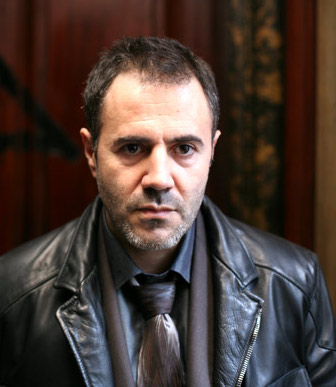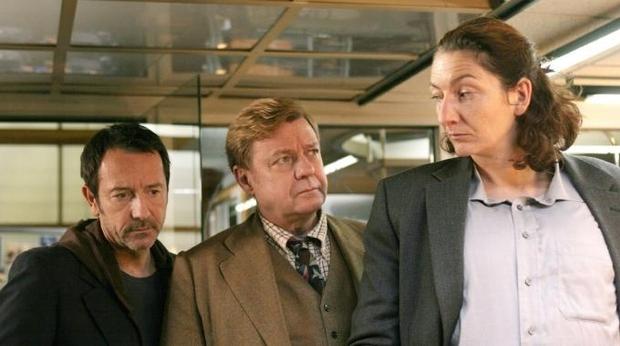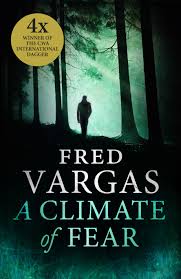This is the ninth title in the tales of Commissar Adamsberg, the vague, unkempt, inquisitive detective, played in a film adaptation superbly by Juan Garcia.
 Juan Garcia as Adamsberg.
Juan Garcia as Adamsberg.
There are also television episodes that have all-star guests like Charlotte Rampling. In the following picture from the television production we have Adamsberg, Danglard, and Retancourt.

The characters are varied and amusing; the dialogue is human and humane; the situations stretch from the mundane to …. Iceland and back.

How does she do it, Fred Vargas, one time professor, now full time writer? Well, I hope she is at it full time because it is a big world and more of it needs Adamsberg, Danglard, and company to resolve its mysteries.
The setup in this title? An elderly woman is found dead in her bath with slashed wrists. She had terminal cancer and the gendarmes call it suicide, and following procedure they photograph the scene and present it to the station chief to sign off and close the file. Bored, he reads the file and looks at the pictures.
Odd that symbol drawn in lipstick on the side of basin.
He calls Danglard, Adamsberg’s number two, famed in the small world of plod for his vast knowledge, retentive memory, and capacity to solve puzzles. Danglard has to see it for himself in situ, and being bored, Adamsberg rides along with Danglard for an outing. The symbol baffles even Danglard and once baffled he cannot quit. Adamsberg is indifferent as they return to their desks.
Then, by chance, a woman comes to the front counter of the nick to make report, but she finds the cop shop all rather distressing and turns to leave, her mission unspoken, but Danglard passes through the lobby and he, of unfailing courtesy, addresses her with great civility. She responds to his politesse, and in short order she reports…. It ties in with the ostensible suicide.
Now Adamsberg reads the file and the plot thickens. Terminally ill or not, why would such a formidable woman lay down fully clothed, hair done, perfumed, nails polished in the tub full of water and cut her wrists? Why would a woman described as determined and self-sufficient, give way? Why is there no suicide note? Why did she struggle in her Zimmer Frame to mail a letter that afternoon?
It all does not add up to zero. There is something more to do it and it meets the eye in the symbol that even Danglard cannot decode.
As ever there are tensions among the officers, numbering about twenty, in this unit. Adamsberg’s loyal number two is Danglard, and there are others who also suspend disbelief in order to be loyal to him, too. It takes suspension because he does go off on tangents, and some do not work, but others do. The tangents come from his intuition which he seldom can explain. Adamsberg is not articulate or learned.
Against this are the positivists in the squad who want facts, finger prints, DNA samples, eye-witnesses before making a move. The metaphysical cloud shovelers who follow Adamsberg are tested in this title, and even Danglard wavers. That phrase ‘cloud shovelers’ was hung on Adamsberg and his deputy in Quebec in an earlier title, but it sticks.
Characterisations are one of Vargas’s strong points. She differentiates her characters and gives them each space, in the way Frank Capra gave character actors camera time, believing it enriches the story, rather than detracting from the protagonist. It sure does. (There days most of the diminishing breed of character actors could be, and sometimes are, replaced by CGI. [Computer Generated Images, Mortimer!])
In this tale there is a thuggish stable man with a police record, who dotes on his horses while imposing discipline on them with whistles and words of kindness that abash both Danglard and Adamsberg. There is a retired nurse who dithers, but is incisive when it counts. There is a spoiled and petulant young man of twenty who has depths none anticipated. Then there are the history re-enactors, some of whom are even odder than Adamsberg.
Most of all there are the regulars, starting with Adamsberg wearing clothes that looked slept-in and probably were, again. Danglard who will never be promoted because he is an alcoholic, a single parent with a brood that takes up a lot of time and energy, and a walking encyclopaedia as far as colleagues can tell. There are many others on the team, like the Amazon Retancourt, who are all watched over the in the office from atop the photocopier by Snowball who figured decisively in one of the earlier tales.
In this title the plot is, as always, complicated, convoluted, and obscure. Yet when it is nailed, it all hangs together. Of course, it is far fetched and some of the touches of the bizarre are, well, bizarre, and probably unnecessary but they have become the decoration on Vargas stories. The bizarre touches, the boar, the mysterious island, are well judged, if distractions.
 Fred Vargas
Fred Vargas
Frédérique Audoin-Rouzeau (1957-), archaeologist by day and krimiest by night. At the Centre National de la Recherche Scientifique and then the Institut Pasteur she specialises in epidemiology, particularly the Black Death in Europe. Her authoritative study is ‘Les chemins de la peste’ (2003). Some dinner table conversation there I expect.
